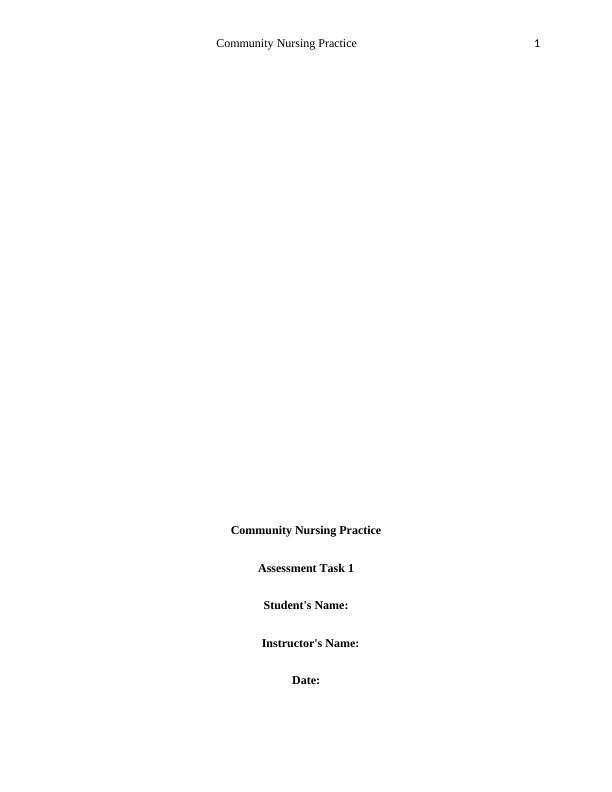Community Nursing Practice - Assignment
9 Pages2517 Words178 Views
Added on 2020-01-28
Community Nursing Practice - Assignment
Added on 2020-01-28
ShareRelated Documents
Community Nursing Practice 1Community Nursing Practice Assessment Task 1Student's Name: Instructor's Name:Date:

Community Nursing Practice 2Community Nursing PracticeThe Yamatji community is the term that describes the prominent Aboriginal tribal section ofAustralia. Predominantly, the Yamatji people inhabit the Murchison and Gascoyne regions ofAustralia. Chronic diseases are commonly prevalent in the indigenous community of Yamtjis orAborginals. The following article studies the concept of community nursing practice fortreatment of Aborginals and the interventions that are required to build trust and efficiency ofnursing practice and treatment in the following sections:1) Effects of discrimination against the Australian Aborginals and TorresStrait Island people:The studies by Reeve et al (2014) and Minges et al (2011) primarily focus on the determinants ofchronic illness (diabetes) in the indigenous populations of Australia. The social factors arecommonly surmised to be the discrimination and differential treatment along with a severe lackof awareness amongst these people about health services. A study by Reeve et al, (2014), statesthat Diabetes mellitus is a highly prevalent disease within indivudals of the Aborginalcommunity of Australia. In the Aborginals, this observation is of specific importance accordingto the National Health Priority Area as recognised by Australian health organization [1]. Theprevalence of type 2 diabetes mellitus is higher in Aborginals as compared to non-Aborginalcommunities worldwide and within Australia [2]. Type 2 diabetes mellitus is also commonlyrecognized amongst the younger population. The occurrence of diabetes leads to an overallcompromise in the health and the quality of life amongst the Aborginals [3]. The commonaetiological and risk factors for diabetes mellitus include obesity, diet, sedentary lifestyle,socioeconomic status, family history, ethnicity etc. The indigenous communities of Australia arenot primarily a part of the homogenous Australian population and thus belong to a lower

Community Nursing Practice 3socioeconomic status [4]. In terms of the socioeconomic statuses and the prevalence of diabetes,there is a marked connection between the social lifestyle factors of these individuals and theprevalence of diabetes. The diversity in the socioeconomic status is an essential consideration inthe study of type 2 diabetes prevalence in the indigenous tribes of Australia. Research is evolvingaround understanding the relevance and distribution of the disease within the indigenouspopulations in Australia [4]. Joan Cunnigham, (2010), has reported the impact of various factorsprevalent amongst the indigenous community of Aborginals on the occurrence of type 2 diabetes[4]. Joan states that socioeconomic factors such as age, gender, employment status, income of thehousehold, educational qualification, ownership of home are all factors that play an importantrole in the occurrence of diabetes [4]. Most times, Aborginals belong to the lower socioeconomicstrata, lack education, and are often homeless. Joan has deduced that the occurrence of chronicdiseases such as diabetes is largely impacted by these social factors [4]. The findings of the studyindicate that the socioeconomic factors have a significant impact on diabetes occurrence butcannot be considered sole predisposing factors to the disease [4]. Indigenous Australians presenta considerable gradient in the socioeconomic status with the non-indigenous groups [4].However, there exists a considerable combination between the indigenous and non-indigenouspopulations and the traditional factors are often not sufficient determiners for the completeunderstanding of the patterns of diabetes occurrence amongst indigenous Australians. Severalcultural factors and social factors contribute to the pattern of diabetes occurrence in theindigenous populations [4]. Familial history and genetic factors among other social and lifestylefactors are combined predisposing factors [4]. Recent research has been studying the varioussocioeconomic and lifestyle factors that contribute to the chronic disease prevalence amongst theAborginal populations of Australia. Whilst it is common belief that the patterns may be uniform

End of preview
Want to access all the pages? Upload your documents or become a member.
Related Documents
Community Nursing Practicelg...
|8
|2309
|223
Chronic Illness and Quality of Health: Association of Income and Healthlg...
|11
|3212
|103
Application Of Epidemiology In Community Health Nursing docx.lg...
|12
|2740
|31
Community Health Choice: || Assignmentlg...
|11
|3194
|21
Determination and Prevention of Diabetes Mellitus: Exploring Factors and Strategies for Healthlg...
|14
|4640
|381
Social Determinants of Health (SDOH) in Australialg...
|16
|3844
|153
